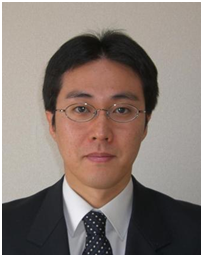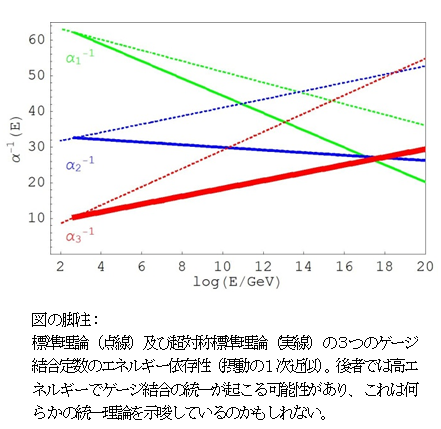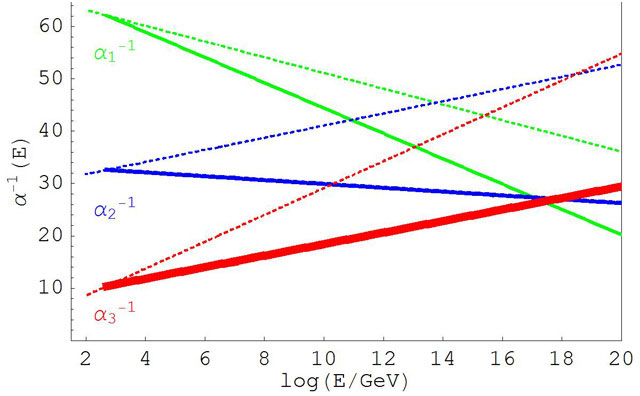
ページ読込中...

ページ読込中...

[English]
| 安倍 博之 [教授] |  |
|
| homepage | https://www.hep.phys.waseda.ac.jp/index-j.html | |
| 専門分野 | 素粒子理論 | |
| 研究テーマ・研究活動 | ||
| ○素粒子標準理論を超える物理 ○超対称理論・高次元時空理論 ○超重力理論・超弦理論の現象論的側面 ○素粒子の究極的統一理論 |
||
| ●日本物理学会 | ||
現在確認されている自然界の最も基本的な構成要素は、クォーク及びレプトンと呼ばれる物質粒子と、それらの間に働く力を媒介する各種のゲージ粒子で、これらをまとめて素粒子と呼びます。私たちの世界のすべての物質は種々の原子から構成されており、これらを拡大してみると原子核の周りを電子が回っているという基本構造が見えますが、原子核は更に陽子や中性子の複合体です。電子はこれ以上分割できず、それ自体がレプトンと呼ばれる素粒子に分類されますが、陽子と中性子は更にクォークと呼ばれる素粒子の複合体であることが分かっています。クォークやレプトンの間に働く力は、電磁気力・弱い力・強い力・重力の4種類があり、これらがうまく働き合って我々の世界が形成されています。重力以外の3つの力は素粒子標準理論と呼ばれるゲージ場の量子論で大変うまく記述できることが実験で確認されていますが、この標準理論にも数々の理論的問題が存在します。例えば(量子論的)重力を含んでいないことや素粒子の質量を定量的に予言できないことなどが挙げられます。
 私たちの研究室では、(現在知られている唯一矛盾のない量子重力理論である)超弦理論の有効理論として標準理論が実現されている可能性を念頭に置いて、素粒子理論の研究、特に標準理論を超える物理の理論的研究を行っています。超弦理論が素粒子の究極的統一理論だとすると、標準理論を超える物理として、ボーズ粒子とフェルミ粒子を入れ換える超対称性や、高次元時空に起因する余剰空間次元の存在などが予言され、これらの力学や幾何学が、観測されている素粒子の複雑な質量階層構造などを決定していると考えられます。また、超対称性や余剰次元から帰結される数々の新粒子の存在は、高エネルギー物理現象や宇宙の歴史にも重要な影響を与えると考えられ、これらの理論を研究し高エネルギー実験や宇宙論的観測による検証を行うことは現代の基礎物理学の重要な課題の1つです。
私たちの研究室では、(現在知られている唯一矛盾のない量子重力理論である)超弦理論の有効理論として標準理論が実現されている可能性を念頭に置いて、素粒子理論の研究、特に標準理論を超える物理の理論的研究を行っています。超弦理論が素粒子の究極的統一理論だとすると、標準理論を超える物理として、ボーズ粒子とフェルミ粒子を入れ換える超対称性や、高次元時空に起因する余剰空間次元の存在などが予言され、これらの力学や幾何学が、観測されている素粒子の複雑な質量階層構造などを決定していると考えられます。また、超対称性や余剰次元から帰結される数々の新粒子の存在は、高エネルギー物理現象や宇宙の歴史にも重要な影響を与えると考えられ、これらの理論を研究し高エネルギー実験や宇宙論的観測による検証を行うことは現代の基礎物理学の重要な課題の1つです。
| Hiroyuki Abe [Professor] |  |
|
| homepage | https://www.hep.phys.waseda.ac.jp | |
| research field | Theoretical high-energy physics | |
| research keywords | ||
| Particle phenomenology Quantum field theory Supersymmetry Supergravity and superstring Higher-dimensional spacetime |
||
| link | ||
| Research Profiles (at Faculty of Science and Engineering) | ||
The most fundamental elements of nature observed by people are elementary particles called quarks, leptons (matter particles), and gauge bosons (force mediators). The electron and the neutrino are classified as leptons, while the proton and the neutron are composite particles each formed by three quarks. A quantum field theory with special local symmetries, called the “standard model” of elementary particles, describes whole observed phenomena at the present time without inconsistencies. From the theoretical point of view, however, there exist many unsatisfactory points in the standard model, beginning with the unpredictability of the masses of elementary particles, the lack of gravitational interactions, and so on.
In a quest for an ultimate fundamental theory of nature beyond the standard mode, one of the most severe obstacles is the extension of quantum field theory as it includes gravitational interactions, i.e. the harmonization of quantum theory with general relativity. A single known theory that overcomes such obstacles without any theoretical inconsistencies is the “superstring theory.” It possesses a special symmetry called supersymmetry under the exchange of bosons and fermions, and is defined in ten-dimensional spacetime. If our real world is a product of superstring theory, there should exist supersymmetry and six extra space dimensions that are possibly hidden in such a way that we never detect them due to the energy shortage of present particle colliders.
Considering the possibility that the standard model appears as a low-energy effective theory for superstring, we perform various theoretical and phenomenological studies for physics beyond the standard model. We have to search candidates for realistic structures among huge numbers of superstring vacua, for which the key ingredients are “supersymmetry” and “extra-dimensions.” These imply the existence of new particles at low energy called superparticles and moduli. We aim to find an ultimate unifying theory of elementary particles and gravity, by analyzing the dynamics and the geometry of these ingredients and accomplishing the harmonization of the standard model with the superstring theory. In these studies, we derive theoretical predictions for precise values of known and possibly new observables, which are compared with real observed values in the past and future high-energy experiments as well as cosmological observations, and then verify the validity of each candidate for an ultimate unified theory of elementary particles.
 The energy dependence of three gauge coupling constants determined by the observed values at low energy in the standard model (dotted-lines) and in a supersymmetric extension of the standard model (solid-lines) at the first order of perturbative expansion. In the latter supersymmetric model, a gauge coupling unification occurs at a high energy, which would imply some underlying unification theory.
The energy dependence of three gauge coupling constants determined by the observed values at low energy in the standard model (dotted-lines) and in a supersymmetric extension of the standard model (solid-lines) at the first order of perturbative expansion. In the latter supersymmetric model, a gauge coupling unification occurs at a high energy, which would imply some underlying unification theory.